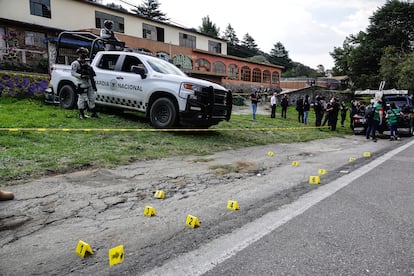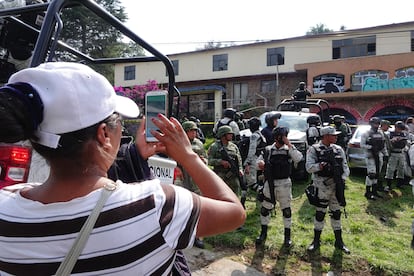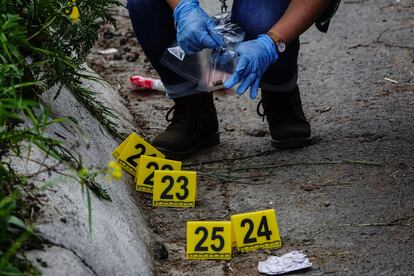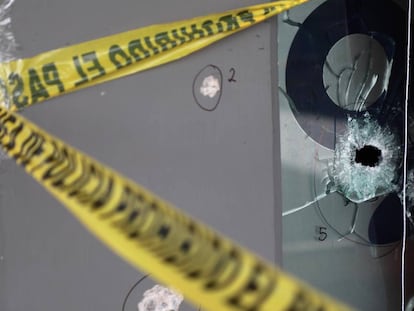Sinaloa cartel: Shootout in Mexico City raises fears of more narco violence
A clash involving a cell linked to drug lord El Chapo’s sons intensifies concerns that the big guns of the trafficking world are ensconced in the country’s financial and political heartland

A shootout between Mexico City police and drug traffickers suspected to be members of the Sinaloa cartel on Tuesday, July 12, has once again sparked fears of narco violence in the country’s financial and political heartland.
When a group of local intelligence agents stumbled upon a criminal cell linked to the sons of drug lord Joaquin “El Chapo” Guzman, they called in reinforcements from the army, and officers armed to the teeth were suddenly swarming across the southern end of the capital. The operation ended with 14 alleged criminals arrested, and drugs and deadly weapons seized, compounding the familiar feeling that nowhere in Mexico is safe from the drug cartels.
The head of the local police, Omar Garcia Harfuch, who has been spearheading the fight against organized crime in the capital for the past three years, and who survived an attack from the powerful Jalisco New Generation cartel in 2020, reiterated that “the Sinaloa cartel and other cartels” have always had a presence in the city. It is not just a question of groups of drug dealers, of which there are dozens, or regional cartels with a lot of local clout, such as Unión Tepito. The two most powerful cartels in the country – Jalisco and Sinaloa – have been spreading their tentacles for years.
Aside from freeing four kidnapped persons, one of whom had been held for more than 20 days, Tuesday’s operation, which began at around 2.30pm, was aimed at tracking down a cell responsible for storing kilos of cocaine in the capital. According to Harfuch, speaking in the wake of a 300-kilo haul of cocaine in June, the cartels “are not looking for territorial control of the area; they are not established as a criminal structure. What they are looking for are comfort zones, warehouses, and houses where they can go unnoticed.”

The presence of the Sinaloa cartel is not new in Mexico City. The political and financial center of the country is also a hub for drug lords. Not only has it served as a refuge and place of residence for drug traffickers, but it is also a place to do business. In May 2017, El Chapo’s right-hand man, Dámaso López, aka El Licenciado (the Graduate), was arrested in one of the capital’s trendiest neighborhoods.
Since 2007, there have been reports from the Mexico City Attorney General’s Office on the presence of the Tijuana, Colima, Juarez, Sinaloa, Gulf and Oaxaca cartels in the capital. In 2007, drug traffickers dumped two severed heads on the awning of a pickup truck in a neighborhood near Benito Juárez International Airport. The heads belonged to Gerardo Santos Iglesias and Carlos Tapia Rosillo, employees of Jet Service, a company that managed storage and administration services for the Lufthansa airline. Three days earlier, Federal Police officers and the General Customs Administration personnel discovered half a ton of cocaine from Colombia in the company’s warehouses.
But though the cartels have always had a presence in the city, their power quota would be agreed with the local narcos. Some are there to sell drugs to what is the largest market in the country, with an estimated population of 20 million between the capital and the State of Mexico; others have their sights set on international trafficking.
The Sinaloa presence in the city may seem innocuous compared to the scenes of terror unfolding in other parts of the country, such as Michoacán, Guanajuato, Jalisco and the northern border states, but Harfuch has recognized that their arsenals are big enough to put the entire city at risk. During Tuesday’s operation, the members of the targeted cell were armed for war. Police seized 10 long guns, 40 mm grenades, more than 70 magazines and a 50-caliber Barret semi-automatic rifle like the one the Jalisco cartel used in 2015 to shoot down a military helicopter.
The operation has so far avoided fatalities, though one local policeman is in a serious condition in hospital after being shot in the head. The three officers who accompanied him, and who were the first to encounter the cell, emerged unscathed.
This is the main difference between a civilian operation and operations launched in the rest of the country against traffickers where, for every member of the security forces killed, there is often at least one suspected criminal gunned down, according to the Defense Ministry – a rate that climbed to eight criminals for every member of the security forces during former president Felipe Calderon’s war on drugs between 2006 and 2012, according to a report by the CIDE social investigation center.

The dismantled cell had been operating in the south of the city for more than two months, according to Harfuch. Complaints from residents together with tracking work on vehicles after the seizure of 32 packages of cocaine in an abandoned van in the Benito Juárez district, led them to the traffickers’ den on the federal highway linking Mexico City to Cuernavaca, near the municipality of San Miguel Topilejo, in the Tlalpan district.
Despite the operation, however, the Sinaloa cartel continues to maintain a presence in the capital alongside other local mafias. According to a report last February presented by security analyst Eduardo Guerrero, director of the consulting firm Lantia and an expert in mapping violence in the country, three gangs maintain territorial control of drugs in the city.
The Tepito Union, whose founder, Oscar Flores Lunares, is now in prison, has a presence in 13 Mexico City neighborhoods and has established itself as the city’s most powerful cartel, with alliances to other criminal groups inside and outside the city, including Los Canchola, led by Lenin Canchola, which controls seven neighborhoods. It is, however, in conflict with Los Rodolfos, led by Julio César Rodríguez, which controls eight. Guerrero pointed out that some bosses continue to operate from jail.
The neighborhoods most affected by the presence of organized crime are Morelos, Rosario, San Juan de Aragón and San Lorenzo Tezonco, which are located in the municipalities of Cuauhtémoc, Azcapotzalco, Gustavo A. Madero and Iztapalapa, respectively.
Tu suscripción se está usando en otro dispositivo
¿Quieres añadir otro usuario a tu suscripción?
Si continúas leyendo en este dispositivo, no se podrá leer en el otro.
FlechaTu suscripción se está usando en otro dispositivo y solo puedes acceder a EL PAÍS desde un dispositivo a la vez.
Si quieres compartir tu cuenta, cambia tu suscripción a la modalidad Premium, así podrás añadir otro usuario. Cada uno accederá con su propia cuenta de email, lo que os permitirá personalizar vuestra experiencia en EL PAÍS.
¿Tienes una suscripción de empresa? Accede aquí para contratar más cuentas.
En el caso de no saber quién está usando tu cuenta, te recomendamos cambiar tu contraseña aquí.
Si decides continuar compartiendo tu cuenta, este mensaje se mostrará en tu dispositivo y en el de la otra persona que está usando tu cuenta de forma indefinida, afectando a tu experiencia de lectura. Puedes consultar aquí los términos y condiciones de la suscripción digital.
More information
Últimas noticias
Most viewed
- Sinaloa Cartel war is taking its toll on Los Chapitos
- Oona Chaplin: ‘I told James Cameron that I was living in a treehouse and starting a permaculture project with a friend’
- Reinhard Genzel, Nobel laureate in physics: ‘One-minute videos will never give you the truth’
- Why the price of coffee has skyrocketed: from Brazilian plantations to specialty coffee houses
- Silver prices are going crazy: This is what’s fueling the rally











































